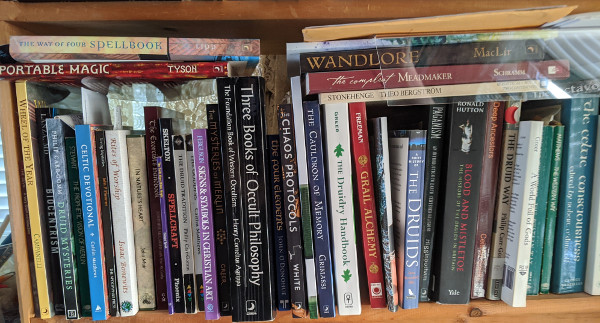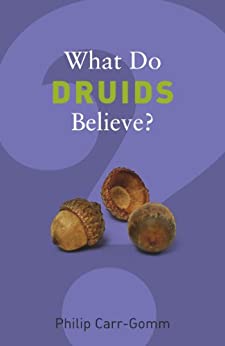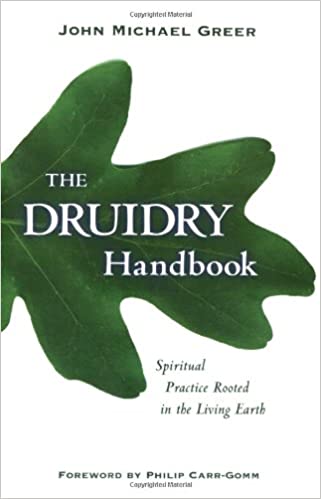[Updated 18 April 2023]

Note: this page does not include links or references for fraternal Druid orders such as OD, the Order of Druids, but focuses on Druidry as a spirituality.
This page lists (a) three good introductory books, (b) five websites of reputable, active and established Druid orders, and (c) other (mostly print) resources.
For a page of links to more groups and to a sample of nearly 30 public figures associated with modern Druidry, see my Voices of Modern Druidry page.
Your suggestions, corrections and additions welcome! Help make this list better!
/|\ THREE GOOD INTROS to DRUIDRY
Note: each title in this section comes from a different Druid group, offering an excellent cross-section of current Druid practices and perspectives.
British Druid Order, The. Druidry: Rekindling the Sacred Fire. The British Druid Order, 2002.
 The 14 short chapters by various authors in this inexpensive and wide-ranging volume cover Druid history, modern practice, distinctive BDO (British Druid Order) perspectives, and crafting objects like robes and rattles. Among the authors are Greywolf (Philip Shallcrass) and Bobcat (Emma Restall Orr), co-founders of the BDO. The BDO maintains an open Facebook page for anyone interested, including BDO members. The BDO exists as an international organization — its name refers to the origin of its practices, not to any restriction on who can join.
The 14 short chapters by various authors in this inexpensive and wide-ranging volume cover Druid history, modern practice, distinctive BDO (British Druid Order) perspectives, and crafting objects like robes and rattles. Among the authors are Greywolf (Philip Shallcrass) and Bobcat (Emma Restall Orr), co-founders of the BDO. The BDO maintains an open Facebook page for anyone interested, including BDO members. The BDO exists as an international organization — its name refers to the origin of its practices, not to any restriction on who can join.
Carr-Gomm, Philip. What Do Druids Believe? London: Granta Books, 2006.
 Carr-Gomm is former Chosen Chief of OBOD (the Order of Bards, Ovates and Druids), which he revived in 1988. In a dozen chapters, he examines what Druids believe and also what they do. What are the roots of the Druid tradition, and how much do we know about the historical Druids? How can one be a Druid in the 21st century?
Carr-Gomm is former Chosen Chief of OBOD (the Order of Bards, Ovates and Druids), which he revived in 1988. In a dozen chapters, he examines what Druids believe and also what they do. What are the roots of the Druid tradition, and how much do we know about the historical Druids? How can one be a Druid in the 21st century?
Also check out Druidry and Other Paths (a subpage of OBOD’s website) — useful posts on connections that may not immediately occur to readers and inquirers but which attest to the living tradition of the Druid path and its possibilities for enriching varied approaches.
Greer, John Michael. The Druidry Handbook: Spiritual Practice Rooted in the Living Earth. York Beach, ME: Red Wheel/Weiser, 2006.
 Much of this volume focuses on what Greer terms the Sun (seasonal celebration), Earth (harmonious living) and Moon (meditation) paths of Druidry. Greer is the former archdruid of AODA (the Ancient Order of Druids in America). He blogged on the influential Archdruid’s Report, and has authored more than 30 books, both non-fiction and fiction, many addressing how to navigate climate change and the shift away from a petroleum-burning economy and culture to more sustainable practices.
Much of this volume focuses on what Greer terms the Sun (seasonal celebration), Earth (harmonious living) and Moon (meditation) paths of Druidry. Greer is the former archdruid of AODA (the Ancient Order of Druids in America). He blogged on the influential Archdruid’s Report, and has authored more than 30 books, both non-fiction and fiction, many addressing how to navigate climate change and the shift away from a petroleum-burning economy and culture to more sustainable practices.
/|\ FIVE GOOD WEBSITES of ACTIVE DRUID ORDERS (in alphabetical order)
Each of these substantial sites and Druid groups offers useful and interesting information and subpages to explore. Each of the four groups is also a teaching order, offering excellent study programs (and in most cases, previews of materials to help you get a sense of them before committing).
ADF (A Druid Fellowship/Ár nDraíocht Féin) http://www.adf.org; founded 1983.
AODA (Ancient Order of Druids in America) https://www.aoda.org; founded 1912 (see website for more detailed history).
BDO (British Druid Order) https://www.druidry.co.uk. Note: the BDO exists as an international organization — its name refers to the origin of its practices, not to any restriction on who can join; founded 1979.
IWOD (Isle of Wight Order of Druidry) https://wightorderdruids.com/; founded 2018, offering free courses. Its North American branch is active online.
OBOD (Order of Bards, Ovates and Druids). https://www.druidry.org; founded 1964.
In addition to official websites, each of these groups also maintains other active sites on a range of social media (Facebook in particular) where you can ask questions, get recommendations for how to pursue your particular interests, find out about activities local to your area, network, and learn more about groups and activities you might be interested in.
/|\ OTHER USEFUL RESOURCES
Beckett, John. The Path of Paganism: An Experience-Based Guide to Modern Pagan Practice. Llewellyn, 2017.
Beckett also maintains a lively blog at Under the Ancient Oaks on the Patheos website.
Billington, Penny. The Path of Druidry: Walking the Ancient Green Way. Llewellyn, 2011.
Billington is an author of a Druid detective series, a musician, an OBOD member and a student of the teachings of Dion Fortune. Her book is a good guide for solitary practitioners.
Carr-Gomm, Philip. The Elements of the Druid Tradition. Shaftesbury, Dorset, and Rockport, MA: Element Books, 1991.
A compact but informative volume in a solid series, in which Carr-Gomm focuses on who the Druids are now — which is also the title of his second chapter. He explores the Classical three-part division of Druids into Bards, Ovates and Druids, looks at the Eightfold Year of ceremonies and their significance, and considers treelore, circles, stones and spirit.
Cudby, Paul. The Shaken Path: A Christian Priest’s Exploration of Modern Pagan Belief and Practice. Christian Alternative, 2017.
This book merits reflection, and stands as a fine model of respectful inquiry, engagement and exploration of another’s path. You might choose it to hand to Christian friends and family.
Damh the Bard‘s Youtube channel and website:
Dave Smith is the Pendragon of OBOD, a musician, workshop leader, head of Anderida Grove in the UK. His monthly Druidcast podcast of music and interviews, his genial presence in performances, and his remarkable and growing repertoire of singable songs and visionary music continue to inspire many. (Can you tell I’m a fan?)
Druidcast — Dave Smith’s (Damh the Bard’s) lively monthly podcast of interviews, music and more. A remarkable resource — now more than 150 episodes to listen to.
Ellis, Peter Berresford. A Brief History of the Druids. Philadelphia: Running Press Book Publishers, 2002.
While focusing more on the ancient Druids, Ellis does devote a final chapter to subsequent developments up to the time of writing.
Freeman, Mara. Grail Alchemy: Initiation in the Celtic Mystery Tradition. Destiny Books, 2014.
“The Holy Grail won’t go away”, Freeman begins. With exercises, visualizations, folk traditions, materials from Medieval romances, she demonstrates how the “primal myth of Western culture” still has much to say to us today, and how to hear it and put it into practice. Her website: Chalice Centre.
Green, Miranda. The World of the Druids. London: Thames and Hudson, paperback ed., 2005.
Both scholarly and popular, with nearly 300 photos, drawings, and other illustrations. Traces the Druids from earliest times to the present.
Greer, John Michael. A World Full of Gods: an Inquiry into Polytheism. Tucson, AZ: ADF Publishing, 2005.
While Druids are just as diverse in their beliefs and perspectives as any group of humans and include atheists, animists, monotheists, Buddhists, and Christians, Greer treats polytheism as a viable religious option, and offers an engaging and witty examination of polytheist beliefs, history, and implications.
Greer, John Michael. Mystery Teachings from the Living Earth: An Introduction to Spiritual Ecology. Llewellyn, 2012.
A thoughtful re-imagining of the seven laws of the 1912 Kybalion (link to edition at Internet Sacred Text Archive) as meditations and principles underlying ecology and earth spirituality.
Greer, Mary K. 21 Ways to Read a Tarot Card. St. Paul, MN: Llewellyn Publications, 2008.
An experienced author and workshop leader, Greer opens doors to creative readings with the Tarot, teaching through creativity, intuition and experimentation rather than dogmatically. A playful yet profound way of working that can be adapted to many forms of Druidry.
Higginbotham, Joyce and River. Paganism: An Introduction to Earth-Centered Religions. Llewellyn, 2002.
A good book for exploring your own current beliefs and practices, with exercises, meditations, etc., as well as learning about what that relative or friend who’s “gone Pagan” has gotten into now. Excellent for anyone looking to gain a solid overview of the range of Pagan traditions.
Hughes, Kristoffer. As the Last Leaf Falls: A Pagan’s Perspective on Death, Dying & Bereavement. Llewellyn, 2020.
A reissue of his previous (2014) The Journey into Spirit, with the same subtitle, this is a singular book. Deeply informed by Hughes’ unique background in mortuaries/morgues as an anatomical pathologist, and as head of a Welsh Druid order, Urdd Derwyddon Mon. Meditations, rituals, and helpful perspectives. Hughes’ other books are also worth reading, particularly his recent Cerrudwen: Celtic Goddess of Inspiration (Llewellyn, 2021).
Hutton, Ronald. Blood and Mistletoe: The History of the Druids in Britain. Yale University Press, 2009.
Hutton is professor of history at the University of Bristol and author of over a dozen books on British folklore, early history and Paganism. Recently elected Fellow of the British Academy, he is a frequent presenter at both academic and Pagan venues. Hutton skillfully treads the middle path between academic rigor and informed sympathy for Pagan and Druid perspectives. Blood and Mistletoe is scholarly, thorough, detailed and engaging. This will likely be the standard work on the subject for some time to come.
Hutton, Ronald. Stations of the Sun: A History of the Ritual Year in Britain. Oxford University Press, 1996.
Lanza, Robert, MD. Biocentrism: How Life and Consciousness are the Keys to Understanding the True Nature of the Universe. Dallas, TX: Benbella Books, 2009.
Difficult to summarize compactly, Lanza’s book points to biology rather than physics as the foundation to understanding: “life creates the universe, rather than the other way around”.
Lipp, Deborah. The Way of Four Spellbook: Working Magic with the Elements. Llewellyn, 2006.
Practical guidance for working with the classical four elements of earth, air, fire and water, written from a Wiccan perspective, with an emphasis on achieving spiritual and elemental balance.
Matthews, Caitlin. The Celtic Devotional: Daily Prayers and Blessings. Harmony, 1996.
Daily, weekly and seasonal meditations, blessings and prayers for Celtic-themed spiritual practice. Matthews is a widely-published author and presenter at conferences. In addition to its value as a devotional, Matthews’ book serves as inspiration for those looking to craft their own prayers, rites and ceremonies.
O’Donohue, John. The Four Elements. Transworld Ireland, 2010; Anam Cara; other titles.
Poet, philosopher and former priest, O’Donohue wrote several magical and evocative books that convey a mystic’s love and sensitivity to the cosmos. Subtly interspersed among his poems and meditations in The Four Elements are suggestions for spiritual practices with earth, air, fire and water. His work is a significant influence on the stream of Celtic Christianity that feeds into Druidry (and vice versa).
O’Driscoll, Dana. Sacred Actions: Living the Wheel of the Year through Earth-centered Sustainable Practices. Atglen, PA: Red Feather, 2021.
O’Driscoll is Grand Archdruid of AODA and an active, insightful and wise blogger at The Druid’s Garden. You can read my review of Sacred Actions here. Her Tree Oracle and its companion volume are especially helpful to Druids in North America, where species, ecologies and geologies differ sometimes dramatically from those found in Europe and the U.K. specifically.
Schneider, Michael S. A Beginner’s Guide to Constructing the Universe: The Mathematical Archetypes of Nature, Art and Science. Harper Perennial, 2014.
An excellent book for studying symbolism, natural patterns, archetypes, art, drawing, proportion, harmonics, symmetry, spirituality — essential training to pay attention to the beauty and form and harmonic shapes all around us in nature, art, science, technology, life … Lots of illustrations, and practical work with a compass and ruler to draw many of the forms to get a feel for them firsthand.
Serith, Ceisiwr. Deep Ancestors: Practicing the Religion of the Proto-Indo-Europeans. Tucson, AZ: ADF Publishing, 2007.
A fascinating look at the world-view of the Proto-Indo-Europeans, the linguistic and cultural ancestors of nearly half the current population on the planet. Recommended for anyone interested in Reconstructionist Paganism, focused on reviving ancient practices as far as they can be deduced from myth, religion, and ancient literatures and languages. Serith makes sense of a lot of information from widely scattered sources. You can find his extensive website here.
“Seven Gifts of Druidry” — OBOD Youtube video — length: 6:13.
Stewart, R. J. (1987). Living Magical Arts: Imagination and Magic for the 21st Century. London: Blandford.
In his many books, workshops and techniques, Stewart clears away much nonsense about magic and provides powerful ways of thinking and working. His workshops and other books are all well worth exploring. See website: rjstewart.org.
Thoreau, Henry David. Walden. Free editions online: Sacred Texts edition (probably most readable); Project Gutenberg; 1854 Internet Archive edition; Intratext edition.
One of the wisest and wittiest books that the West has produced in the last 200 years. H. D. Thoreau lived in a cabin by Walden Pond in Massachusetts from July 1845 to September 1847, and wrote this book about his experience. Thoreau notes, “I went to the woods because I wished to live deliberately, to front only the essential facts of life, and see if I could not learn what it had to teach, and not, when I came to die, discover that I had not lived”. Thoreau is an ancestral presence to today’s environmental movement and earth spiritualities, as well as a mentor capable of puncturing hypocrisy and sloppy thinking, while provoking useful re-assessment and self-evaluation.
/|\ /|\ /|\
